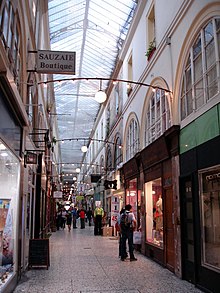Arcades Project

Das Passagen-Werk or Arcades Project was an unfinished project of German philosopher and cultural critic
Benjamin's Project, which many scholars[1] believe might have become one of the great texts of 20th-century cultural criticism, was never completed due to his suicide on the French-Spanish border in 1940. The Arcades Project has been posthumously edited and published in many languages as a collection of unfinished reflections. The work is mainly written in German, yet also contains French-language passages, mainly quotes.
Overview
Parisian arcades began to be constructed around the beginning of the nineteenth century and were sometimes destroyed as a result of
Benjamin first mentioned the Arcades Project in a 1927 letter to his friend Gershom Scholem, describing it as his attempt to use collage techniques in literature.[3] Initially, Benjamin saw the Arcades as a small article he would finish within a few weeks.[4]
However, Benjamin's vision of the Arcades Project grew increasingly ambitious in scope until he perceived it as representing his most important creative accomplishment. On several occasions Benjamin altered his overall scheme of the Arcades Project, due in part to the influence of
It contains sections (convolutes) on
.It influenced
Structure
The project's structure is idiosyncratic. The convolutes correspond to letters of the alphabet; the individual sections of text— sometimes individual lines, sometimes multi-paragraph analyses —are ordered with square brackets, starting from [A1,1]. This numbering system comes from the pieces of folded paper that Benjamin wrote on, with [A1a,1] denoting the third page of his 'folio.'[6] Additionally, Benjamin included cross-references at the end of some sections. These were denoted by small boxes enclosing the word (e.g., ■ Fashion ■).[7]
The sections of text are at times Benjamin's own thoughts, and at other times consecutive quotations. These two types of textual sections are differentiated in their typography, with a large typeface for his writing and a smaller one for citations. This convention comes from the German version, but has no basis in Benjamin's manuscript. The convolutes also make extensive use of epigraphs from obscure publications.
Publication history
The notes and manuscript for the Arcades Project and much of Benjamin's correspondence had been entrusted to Benjamin's friend
The full text of Benjamin's unfinished magnum opus was published in English translation by Harvard University Press in 1999 after years of difficult editorial work undertaken by Rolf Tiedemann, the editor of the landmark 1982 German edition.
The Arcades Project, as it stands, is often claimed to be a forerunner to postmodernism.[9]
Notes
- ^ Agamben, Giorgio (1993). Stanzas. Minneapolis: Uni. go Minnesota Press. pp. xvii.
- ISBN 978-0-674-00802-1.
- ^ a b Lilla, Mark (May 25, 1995). "The Riddle of Walter Benjamin" (preview only; subscription required). Review of The Correspondence of Walter Benjamin, 1910–1940. The New York Review of Books. Retrieved 2017-07-29.
- ISBN 978-0-226-04237-4.
- ^ Buck-Morss, Susan. Seeing/Making. Inventory Press. p. 157.
- OCLC 41176710.
- OCLC 41176710.
- ISBN 978-0-674-05186-7.
- ^ "Archiveology". Research in Film and History. Retrieved 2023-09-19.
Bibliography
Primary source
- Walter Benjamin (2002), Rolf Tiedemann (ed.), The Arcades Project, New York: Belknap Press, p. 1088, ISBN 0-674-00802-2Howard Eiland and Kevin McLaughlin (Translators)
Secondary sources
- ISBN 0-262-52164-4
- ISBN 978-1546942092
- Beatrice Hanssen (ed) Walter Benjamin And the Arcades Project (Walter Benjamin Studies), London: Continuum International Publishing Group, 2006), 256 pages. (English) ISBN 0-8264-6387-8.
- David Kishik, "The Manhattan Project: A Theory of a City." (Stanford: Stanford University Press, 2015), 288 pages. ISBN 978-1-50360-277-9(paper)
- Duy Lap Nguyen. (2022). Walter Benjamin and the Critique of Political Economy : A New Historical Materialism. London UK: Bloomsbury Academic.
